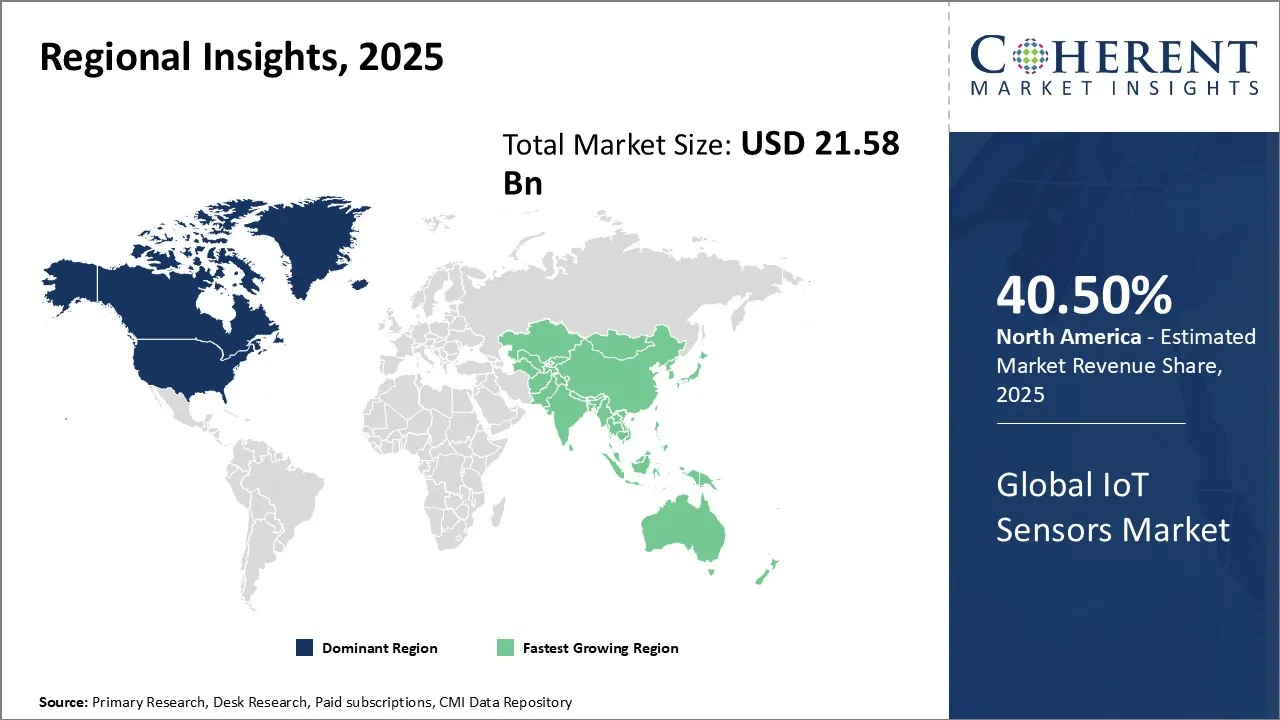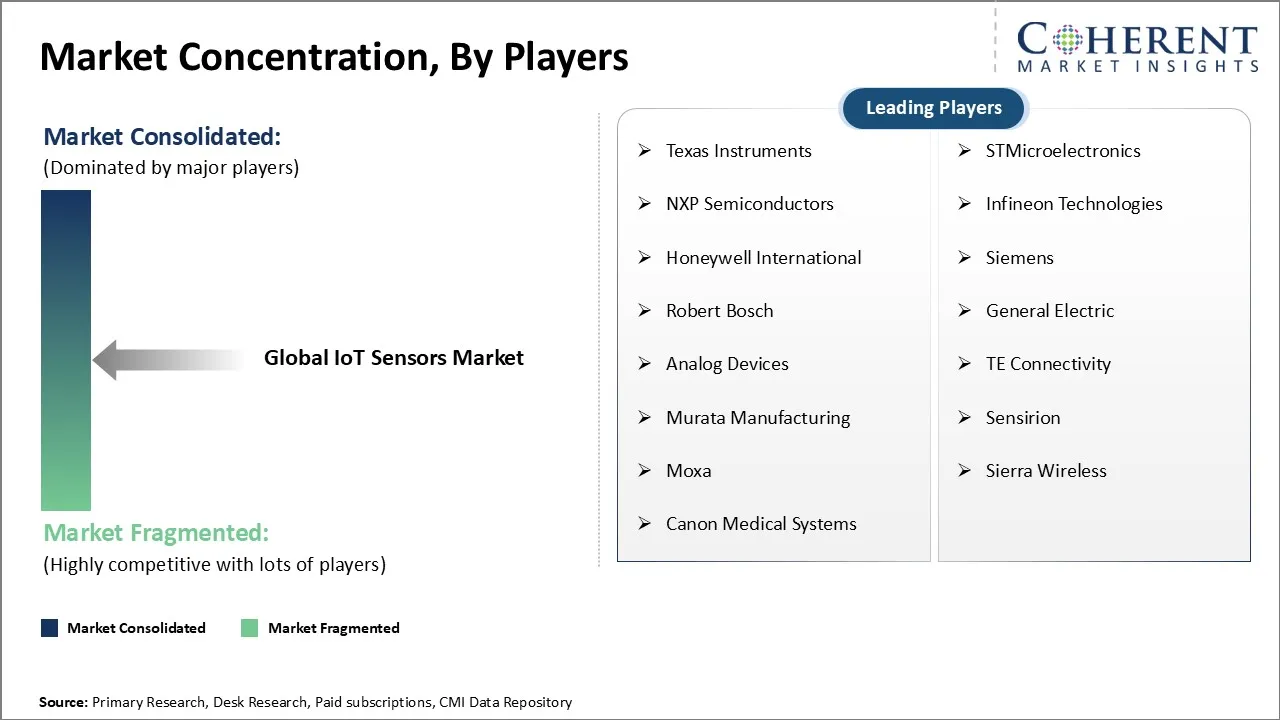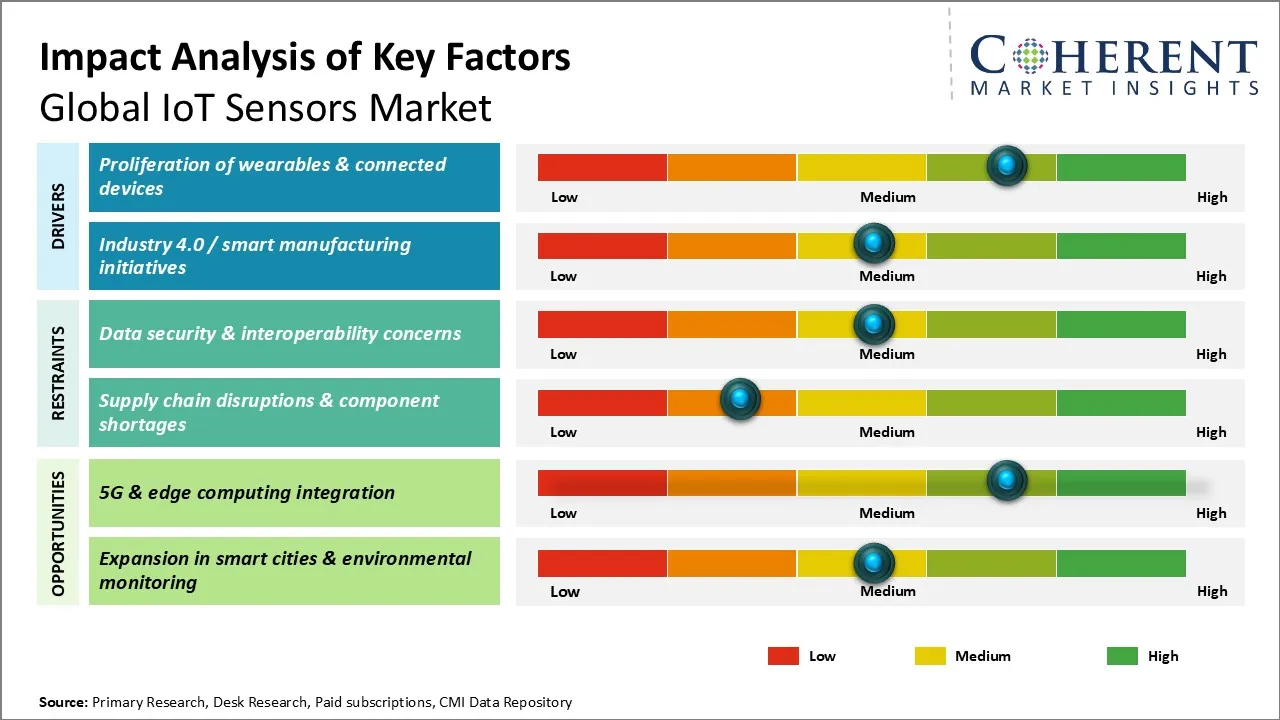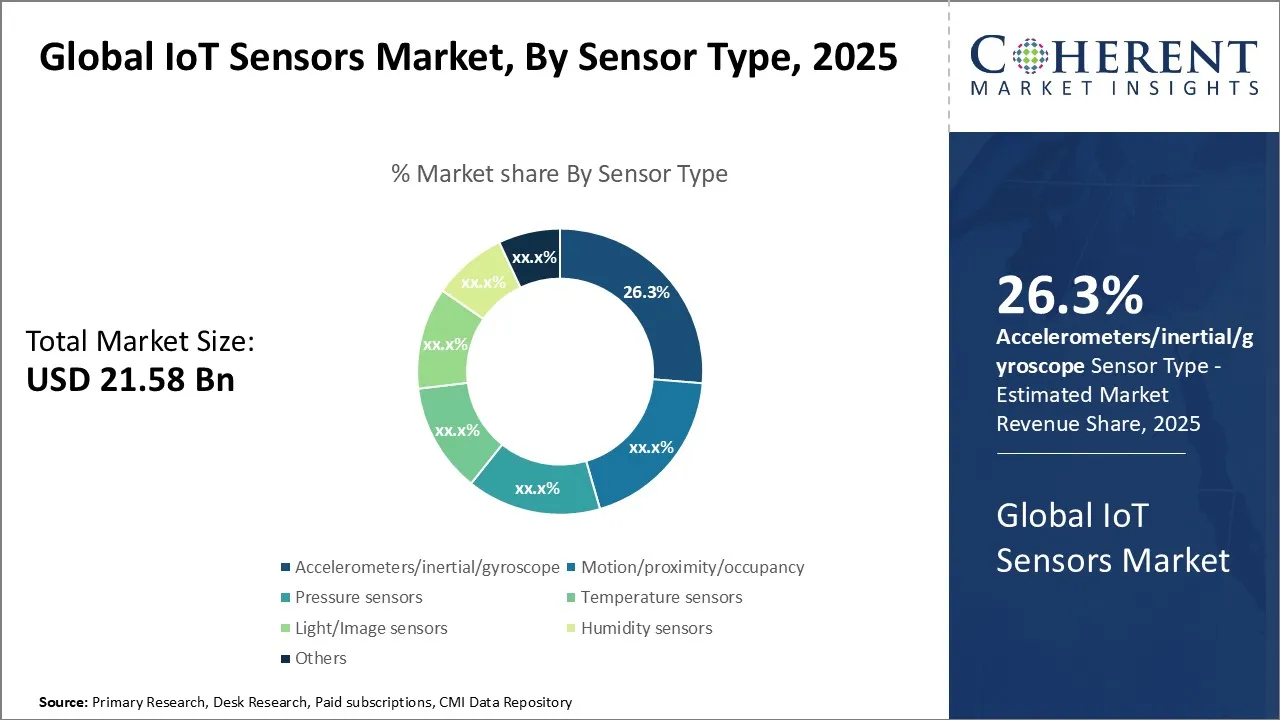Global IoT Sensors Market Size and Forecast – 2025-2032
The Global IoT Sensors Market is estimated to be valued at USD 21.58 Bn in 2025 and is expected to reach USD 188.59 Bn by 2032, exhibiting a compound annual growth rate (CAGR) of 36.3% from 2025 to 2032.
Key Takeaways of the Global IoT Sensors Market
- The accelerometers/inertial/gyroscope sensors segment leads the market, holding an estimated share of 26. 3% in 2025.
- The wireless segment leads the market, holding an estimated share of 78. 8% in 2025.
- North America is estimated to lead the market with a share of 40. 5% in 2025.
- Asia Pacific, holding a share of 34. 5% in 2025, is projected to be the fastest growing region.
Market Overview
The IoT sensors market is seeing many trends, including the development of advanced sensor technologies, such as MEMS and nanosensors, which offer improved accuracy, reliability, and energy efficiency. Furthermore, the growing demand for wearable devices and smart home applications is driving the adoption of IoT sensors in the consumer sector, while the increasing focus on Industry 4.0 and smart factory initiatives is boosting the demand for IoT sensors in the industrial sector.
Current Events and Its Impact
|
Current Events |
Description and its impact |
|
Accelerated Adoption of 5G Networks Worldwide |
|
|
Growing Economic Uncertainty and Inflation |
|
Uncover macros and micros vetted on 75+ parameters: Get instant access to report
Global IoT Sensors Market Insights, by Sensor Type – Accelerometers/Inertial/Gyroscope Sensors Dominate Due to their Versatility and Wide Range of Applications
Accelerometers/inertial/gyroscope segment is estimated to contribute the highest share of 26.3% in the market in 2025. Smartwatches, fitness trackers, and virtual reality headsets use these sensors to provide precise motion tracking and orientation data. In 2024, Bosch Sensortec launched the BMI323, a 6-axis Inertial Measurement Unit (IMU) designed specifically for wearables and smart home devices. It offers high performance in motion sensing with ultra-low power consumption.
Modern vehicles are also use many IoT sensors, including accelerometers and gyroscopes for applications such as stability control, navigation, and collision detection. The increasing adoption of advanced driver assistance systems (ADAS) and the development of autonomous vehicles further fuel the demand for these sensors.
Moreover, the industrial sector is seeing a lot of adoption of IoT sensors for condition monitoring, predictive maintenance, and asset tracking. Accelerometers and gyroscopes help detect vibrations, tilt, and motion in industrial equipment, making possible early fault detection and preventive maintenance. The growing emphasis on Industry 4.0 and smart manufacturing is expected to drive the demand for these sensors in industrial applications.
Global IoT Sensors Market Insights, by Network Technology - Wireless Technology Leads the Way in the Global IoT Sensors Market
The wireless segment is expected to contribute the highest share of 78.8% in the global IoT sensors market in 2025. The proliferation of wireless communication technologies, such as Wi-Fi, Bluetooth, Zigbee, and cellular networks (4G/5G), has revolutionized the IoT ecosystem, enabling seamless connectivity and data transmission between sensors and IoT devices. Wireless sensors, such as temperature, humidity, and motion sensors, are extensively used in smart home applications for energy management, security, and convenience.
The development of low-power wide-area networks (LPWAN), such as LoRaWAN and NB-IoT, has further accelerated the adoption of wireless sensors in IoT applications. These technologies enable long-range communication with low power consumption, making them suitable for battery-operated sensors deployed in remote locations or large-scale IoT networks.
The wireless segment's growth is also supported by the continuous advancements in wireless communication technologies. The introduction of 5G networks, with their high bandwidth, low latency, and massive device connectivity, is expected to open up new opportunities for wireless IoT sensors in applications such as autonomous vehicles, smart cities, and industrial automation.
Impact of Artificial Intelligence (AI) on the IoT Sensors Market
Artificial intelligence (AI) plays a transformative role in the IoT sensors market by enabling smarter data interpretation, predictive analytics, and autonomous decision-making. With billions of sensors generating massive volumes of data, AI helps filter, analyze, and derive actionable insights in real time. Machine learning algorithms embedded in IoT platforms can detect anomalies, predict equipment failures, and optimize resource utilization across industries like manufacturing, healthcare, and smart cities. AI also enhances the accuracy and efficiency of sensor networks by supporting edge computing — reducing latency and bandwidth consumption while enabling faster local decisions.
Bosch Sensortec’s BHI380 is an AI-enabled smart sensor launched in 2024 for wearables and fitness devices. The BHI380 integrates AI directly into the sensor hardware, allowing motion and gesture recognition to happen locally without needing constant cloud connectivity.
Regional Insights

To learn more about this report, Download Free Sample
North America IoT Sensors Market Analysis and Trends
North America is expected to hold the largest share of 40.5% in the global IoT sensors market in 2025, driven by its advanced technology infrastructure, early adoption of IoT solutions, and strong presence of leading players like Texas Instruments, Honeywell International, and Analog Devices. The region’s focus on industrial automation, smart cities, and connected healthcare continues to fuel the demand for advanced sensors across sectors. For example, General Electric’s Predix platform uses millions of industrial IoT sensors deployed across North American manufacturing and energy sites to enable predictive maintenance and real-time operational insights.
In 2024, Honeywell launched its Smart Environmental Sensors, that monitor air quality, temperature, humidity, and occupancy in real time, enabling Heating, Ventilation, and Air Conditioning (HVAC) systems to self-optimize.
Asia Pacific IoT Sensors Market Analysis and Trends
Asia Pacific, holding a share of 34.5% in 2025, is the fastest growing IoT sensors market, propelled by rapid industrialization, urbanization, and massive investments in smart infrastructure across countries like China, India, Japan, and South Korea. The region benefits from robust growth in sectors such as automotive, consumer electronics, and smart agriculture. Notable players like STMicroelectronics, Murata Manufacturing, and Moxa are expanding their operations and partnerships to serve this surging demand.
Global IoT Sensors Market Outlook for Key Countries
U.S. IoT Sensors Market Analysis and Trends
The U.S. sees significant deployment of sensors in smart manufacturing, connected vehicles, and healthcare IoT. General Electric’s industrial IoT ecosystem includes millions of sensors monitor equipment health in energy plants and factories to optimize uptime and maintenance. Notable players shaping the U.S. IoT sensors market include Honeywell International, Texas Instruments, Analog Devices, and Qualcomm.
China IoT Sensors Market Analysis and Trends
China is seeing aggressive smart city programs, a huge manufacturing sector, and rapid digitalization. The country uses sensors in smart grids, urban infrastructure, and industrial automation. For example, State Grid Corporation offers smart meters and grid sensors that enable real-time monitoring and optimization of power distribution across the country. Key players active in the market include Huawei, Xiaomi (IoT devices), Bosch (through partnerships), and STMicroelectronics.
Germany IoT Sensors Market Analysis and Trends
Germany is seeing a lot of innovation in IoT sensors, driven by its leadership in Industry 4.0 and automotive technology. Sensors are widely used in precision manufacturing, logistics, and energy-efficient building systems. Siemens uses IoT sensors in its factories, making possible predictive maintenance and energy optimization with near-zero defects. Major players shaping the German IoT sensor landscape include Bosch Sensortec, Siemens, Infineon Technologies, and Hella.
India IoT Sensors Market Analysis and Trends
India is one of the fastest-growing IoT sensors markets, fueled by smart city initiatives, expanding industrial automation, and the rise of affordable connected devices. The country is using sensors for applications like water management, smart lighting, traffic monitoring, and agricultural IoT. The BharatNet project integrates IoT sensors in rural broadband networks to monitor and manage connectivity and service health. Major players in the country include Robert Bosch Engineering India, Moxa, and SenseGiz.
Market Players, Key Development, and Competitive Intelligence

To learn more about this report, Download Free Sample
Top Strategies Followed by Global IoT Sensors Market Players
- Established players are investing heavily in R&D to develop cutting-edge sensor technologies that offer superior performance, reliability, and energy efficiency.
- In 2024, Texas Instruments announced the expansion of its sensor R&D center in Germany, focusing on next-generation low-power, high-precision sensors for industrial IoT and automotive applications.
- Mid-level players are adopting strategies focused on delivering cost-effective solutions to target price-sensitive consumers.
- Sensirion AG, a mid-tier global sensor supplier, introduced its SHT40 SmartGadget in 2023 — a cost-efficient humidity and temperature sensor module targeted at mass-market smart home and consumer applications.
- Small-scale players are focusing on specialized segments to differentiate themselves from larger competitors
- Morse Micro, a small but fast-growing player, has carved out a niche by focusing on Wi-Fi HaLow IoT sensor modules designed for long-range, low-power industrial and agricultural applications.
Key Developments
- In May 2024, Sensirion introduced Sensirion SLD3x Miniature Digital Liquid Flow Sensors, compact sensors that improve subcutaneous drug delivery in medical applications
- In January 2024, Bosch unveiled cutting edge Smart Connected Sensors platform for full-body motion tracking
- In November 2023, Siemens announced an investment of USD 150 million in a new high-tech manufacturing plant in Dallas-Fort Worth, U.S., to help power American data centers and critical infrastructure
- In August 2023, ABB invested in a strategic partnership with Pratexo, an edge-to-cloud acceleration platform company. The partnership involved a minority investment in Pratexo through ABB’s venture capital unit, ABB Technology Ventures (ATV).
Market Report Scope
IoT Sensors Market Report Coverage
| Report Coverage | Details | ||
|---|---|---|---|
| Base Year: | 2024 | Market Size in 2025: | USD 21.58 Bn |
| Historical Data for: | 2020 To 2024 | Forecast Period: | 2025 To 2032 |
| Forecast Period 2025 to 2032 CAGR: | 36.3% | 2032 Value Projection: | USD 188.59 Bn |
| Geographies covered: |
|
||
| Segments covered: |
|
||
| Companies covered: |
Texas Instruments, STMicroelectronics, NXP Semiconductors, Infineon Technologies, Honeywell International, Siemens, Robert Bosch, General Electric, Analog Devices, TE Connectivity, Murata Manufacturing, Sensirion, Moxa, Sierra Wireless, and Canon Medical Systems |
||
| Growth Drivers: |
|
||
| Restraints & Challenges: |
|
||
Uncover macros and micros vetted on 75+ parameters: Get instant access to report
Market Dynamics

To learn more about this report, Download Free Sample
Global IoT Sensors Market Driver - Proliferation of Wearables & Connected Devices
The increasing adoption of smartwatches, fitness trackers, and other wearable devices has created a substantial demand for IoT sensors capable of collecting and transmitting real-time data. These sensors enable wearables to monitor vital signs, track physical activity, and provide personalized insights to users. For example, the Apple Watch Series 10, launched in 2024, features enhanced health sensors capable of continuous glucose monitoring and body temperature sensing.
Moreover, the surge in connected devices, such as smart home appliances, smart meters, and industrial equipment, is further augmenting the need for IoT sensors. These sensors play a crucial role in facilitating seamless communication and data exchange between devices, enabling automation, remote monitoring, and efficient resource management.
Global IoT Sensors Market Opportunity - 5G & Edge Computing Integration
The advent of 5G technology brings forth a new era of connectivity, offering faster speeds, lower latency, and increased bandwidth compared to its predecessors. This enhanced connectivity enables IoT sensors to transmit data more efficiently and in real-time, opening up new possibilities for applications that require instant decision-making and responsiveness. Additionally, edge computing complements 5G by bringing data processing closer to the source, reducing the need for data to travel long distances to centralized servers. This distributed computing approach minimizes latency and improves the performance of IoT sensors, especially in scenarios where real-time data analysis is critical.
The combination of 5G and edge computing empowers IoT sensors to deliver more advanced and intelligent solutions across various industries, such as smart cities, industrial automation, healthcare, and transportation. It enables the development of innovative applications that leverage the power of real-time data processing, artificial intelligence, and machine learning at the edge. In 2023, China Mobile deployed 5 G-enabled smart traffic systems in Beijing, China. These systems leverage IoT sensors and edge computing to optimize traffic flow and enhance road safety through instantaneous data processing.
Analyst Opinion (Expert Opinion)
- The integration of artificial intelligence directly into sensors and edge devices is transforming IoT applications, enabling real-time analytics, anomaly detection, and predictive maintenance without relying on constant cloud connectivity. This is crucial for latency-sensitive use cases in autonomous vehicles, industrial automation, and healthcare wearables.
- Breakthroughs in self-powered sensors using technologies like piezoelectric, thermoelectric, and RF energy harvesting are making it feasible to deploy sensors in remote, hard-to-reach locations — from structural health monitoring in infrastructure to wildlife tracking in conservation efforts — without the burden of battery replacement.
- Emerging use-cases such as connected factories, smart grids, and precision agriculture are benefiting from 5G’s ultra-reliable low-latency communication, combined with sensor-rich environments. This convergence is enabling massive machine-type communications (mMTC) at scale, laying the foundation for fully autonomous, data-driven systems.
Market Segmentation
- Sensor Type Insights (Revenue, USD Bn, 2020 - 2032)
- Accelerometers/inertial/gyroscope
- Motion/proximity/occupancy
- Pressure sensors
- Temperature sensors
- Light/Image sensors
- Humidity sensors
- Others
- Network Technology Insights (Revenue, USD Bn, 2020 - 2032)
- Wireless
- Wired
- Regional Insights (Revenue, USD Bn, 2020 - 2032)
- North America
- U.S.
- Canada
- Latin America
- Brazil
- Argentina
- Mexico
- Rest of Latin America
- Europe
- Germany
- U.K.
- Spain
- France
- Italy
- Russia
- Rest of Europe
- Asia Pacific
- China
- India
- Japan
- Australia
- South Korea
- ASEAN
- Rest of Asia Pacific
- Middle East
- GCC Countries
- Israel
- Rest of Middle East
- Africa
- South Africa
- North Africa
- Central Africa
- North America
- Key Players Insights
- Texas Instruments
- STMicroelectronics
- NXP Semiconductors
- Infineon Technologies
- Honeywell International
- Siemens
- Robert Bosch
- General Electric
- Analog Devices
- TE Connectivity
- Murata Manufacturing
- Sensirion
- Moxa
- Sierra Wireless
- Canon Medical Systems
Sources
Primary Research Interviews
Stakeholders
- IoT Device Manufacturers
- Industrial Automation System Integrators (e.g., Plant managers, operations heads)
- Smart City Planners and Infrastructure Consultants
- Wireless Technology Providers (e.g., 5G solution architects)
- Automotive OEMs and Tier-1 suppliers (e.g., connected vehicle program managers)
- Environmental Monitoring Agencies (e.g., sensor deployment heads)
Databases
- Global Technology Innovation Database (GTID)
- IoT Standards Consortium Dataset (ISCD)
- World Technology Census
- OECD Digital Economy Data
Magazines
- IoT World Today
- Sensors & Transducers Review
- Embedded Systems Journal
- Smart Infrastructure Magazine
Journals
- Journal of Sensor Networks and Applications
- IEEE Internet of Things Journal
- Sensors and Actuators Letters
- Journal of Wireless Sensor Networks
Newspapers
- The Tech Gazette
- IoT Insider Daily
- Global Business Chronicle
- The Economic Herald
Associations
- International IoT Association (IIoTA)
- Smart Sensors Consortium (SSC)
- Connected Devices Alliance (CDA)
- Wireless IoT Forum
- Industrial Internet Consortium (IIC)
Public Domain Sources
- U.S. Census Bureau
- EUROSTAT
- United Nations Economic Commission for Europe (UNECE)
- World Bank
- ResearchGate
Proprietary Elements
- CMI Data Analytics Tool, Proprietary CMI Existing Repository of information for the last 8 years
Share
Share
About Author
Monica Shevgan has 9+ years of experience in market research and business consulting driving client-centric product delivery of the Information and Communication Technology (ICT) team, enhancing client experiences, and shaping business strategy for optimal outcomes. Passionate about client success.
Missing comfort of reading report in your local language? Find your preferred language :
Transform your Strategy with Exclusive Trending Reports :
Frequently Asked Questions
EXISTING CLIENTELE
Joining thousands of companies around the world committed to making the Excellent Business Solutions.
View All Our Clients


